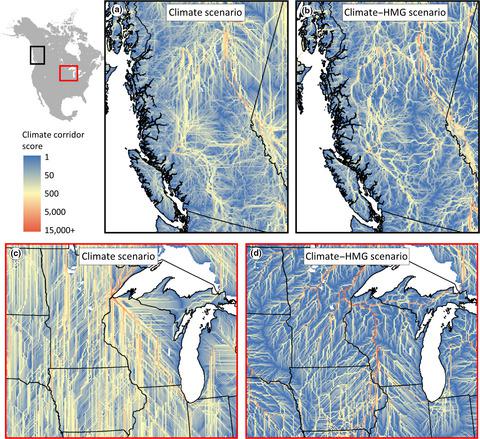当前位置:
X-MOL 学术
›
Glob. Change Biol.
›
论文详情
Our official English website, www.x-mol.net, welcomes your feedback! (Note: you will need to create a separate account there.)
Human land uses reduce climate connectivity across North America.
Global Change Biology ( IF 11.6 ) Pub Date : 2020-02-29 , DOI: 10.1111/gcb.15009 Sean A Parks 1 , Carlos Carroll 2 , Solomon Z Dobrowski 3 , Brady W Allred 3
Global Change Biology ( IF 11.6 ) Pub Date : 2020-02-29 , DOI: 10.1111/gcb.15009 Sean A Parks 1 , Carlos Carroll 2 , Solomon Z Dobrowski 3 , Brady W Allred 3
Affiliation

|
Climate connectivity, the ability of a landscape to promote or hinder the movement of organisms in response to a changing climate, is contingent on multiple factors including the distance organisms need to move to track suitable climate over time (i.e. climate velocity) and the resistance they experience along such routes. An additional consideration which has received less attention is that human land uses increase resistance to movement or alter movement routes and thus influence climate connectivity. Here we evaluate the influence of human land uses on climate connectivity across North America by comparing two climate connectivity scenarios, one considering climate change in isolation and the other considering climate change and human land uses. In doing so, we introduce a novel metric of climate connectivity, 'human exposure', that quantifies the cumulative exposure to human activities that organisms may encounter as they shift their ranges in response to climate change. We also delineate potential movement routes and evaluate whether the protected area network supports movement corridors better than non-protected lands. We found that when incorporating human land uses, climate connectivity decreased; climate velocity increased on average by 0.3 km/year and cumulative climatic resistance increased for ~83% of the continent. Moreover, ~96% of movement routes in North America must contend with human land uses to some degree. In the scenario that evaluated climate change in isolation, we found that protected areas do not support climate corridors at a higher rate than non-protected lands across North America. However, variability is evident, as many ecoregions contain protected areas that exhibit both more and less representation of climate corridors compared to non-protected lands. Overall, our study indicates that previous evaluations of climate connectivity underestimate climate change exposure because they do not account for human impacts.
中文翻译:

人类土地使用减少了整个北美的气候联系。
气候连通性,即景观对气候变化的响应促进或阻碍生物运动的能力,取决于多种因素,包括生物随着时间推移需要移动以追踪合适的气候的距离(即气候速度)及其抵抗力。沿这些路线的经验。引起较少关注的另一个考虑因素是,人类土地使用会增加对运动的抵抗力或改变运动路线,从而影响气候连通性。在这里,我们通过比较两种气候连通性情景来评估人类土地利用对整个北美气候连通性的影响,其中一种情况考虑了孤立的气候变化,另一种考虑了气候变化和人类土地利用。为此,我们引入了一种新的气候连通性指标,即“人类暴露”,量化了生物体因气候变化而改变范围时可能遇到的人类活动的累积暴露。我们还勾画了潜在的移动路线,并评估保护区网络是否比非保护区更好地支持移动走廊。我们发现,如果将人类土地利用纳入考虑范围,气候连通性就会下降。气候速度平均每年增加0.3 km,并且该大陆约83%的累积气候阻力增加。此外,在北美,约96%的迁徙路线必须在一定程度上与人类土地利用竞争。在孤立地评估气候变化的情况下,我们发现保护区对气候走廊的支持率不及整个北美非保护区。但是,可变性是显而易见的,由于许多生态区所包含的保护区与非保护区相比,在气候走廊中所占比例越来越小。总体而言,我们的研究表明,先前对气候连通性的评估低估了气候变化的暴露程度,因为它们没有考虑到人类的影响。
更新日期:2020-02-29
中文翻译:

人类土地使用减少了整个北美的气候联系。
气候连通性,即景观对气候变化的响应促进或阻碍生物运动的能力,取决于多种因素,包括生物随着时间推移需要移动以追踪合适的气候的距离(即气候速度)及其抵抗力。沿这些路线的经验。引起较少关注的另一个考虑因素是,人类土地使用会增加对运动的抵抗力或改变运动路线,从而影响气候连通性。在这里,我们通过比较两种气候连通性情景来评估人类土地利用对整个北美气候连通性的影响,其中一种情况考虑了孤立的气候变化,另一种考虑了气候变化和人类土地利用。为此,我们引入了一种新的气候连通性指标,即“人类暴露”,量化了生物体因气候变化而改变范围时可能遇到的人类活动的累积暴露。我们还勾画了潜在的移动路线,并评估保护区网络是否比非保护区更好地支持移动走廊。我们发现,如果将人类土地利用纳入考虑范围,气候连通性就会下降。气候速度平均每年增加0.3 km,并且该大陆约83%的累积气候阻力增加。此外,在北美,约96%的迁徙路线必须在一定程度上与人类土地利用竞争。在孤立地评估气候变化的情况下,我们发现保护区对气候走廊的支持率不及整个北美非保护区。但是,可变性是显而易见的,由于许多生态区所包含的保护区与非保护区相比,在气候走廊中所占比例越来越小。总体而言,我们的研究表明,先前对气候连通性的评估低估了气候变化的暴露程度,因为它们没有考虑到人类的影响。

























 京公网安备 11010802027423号
京公网安备 11010802027423号